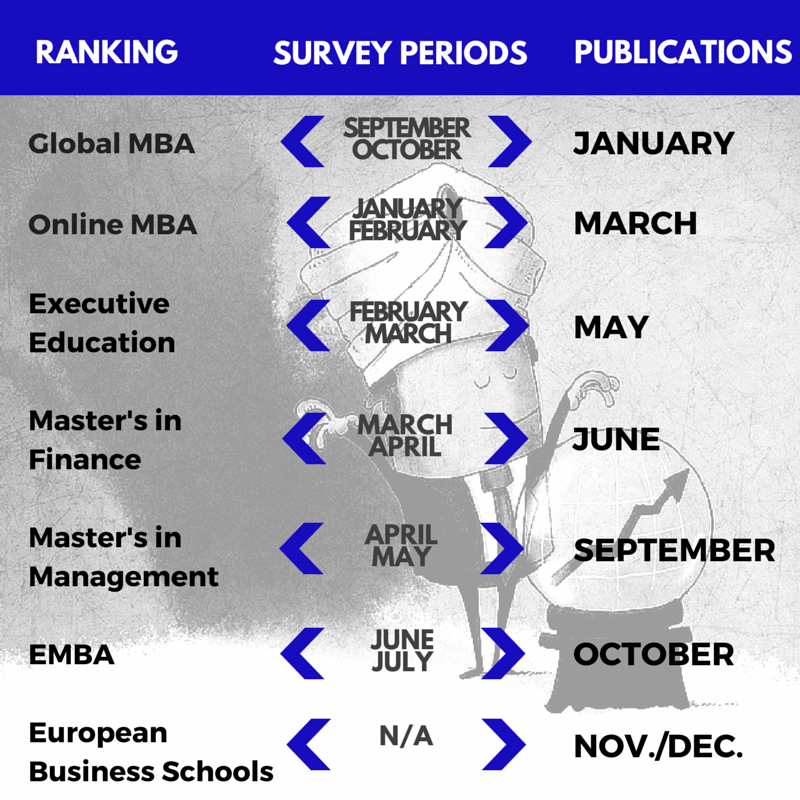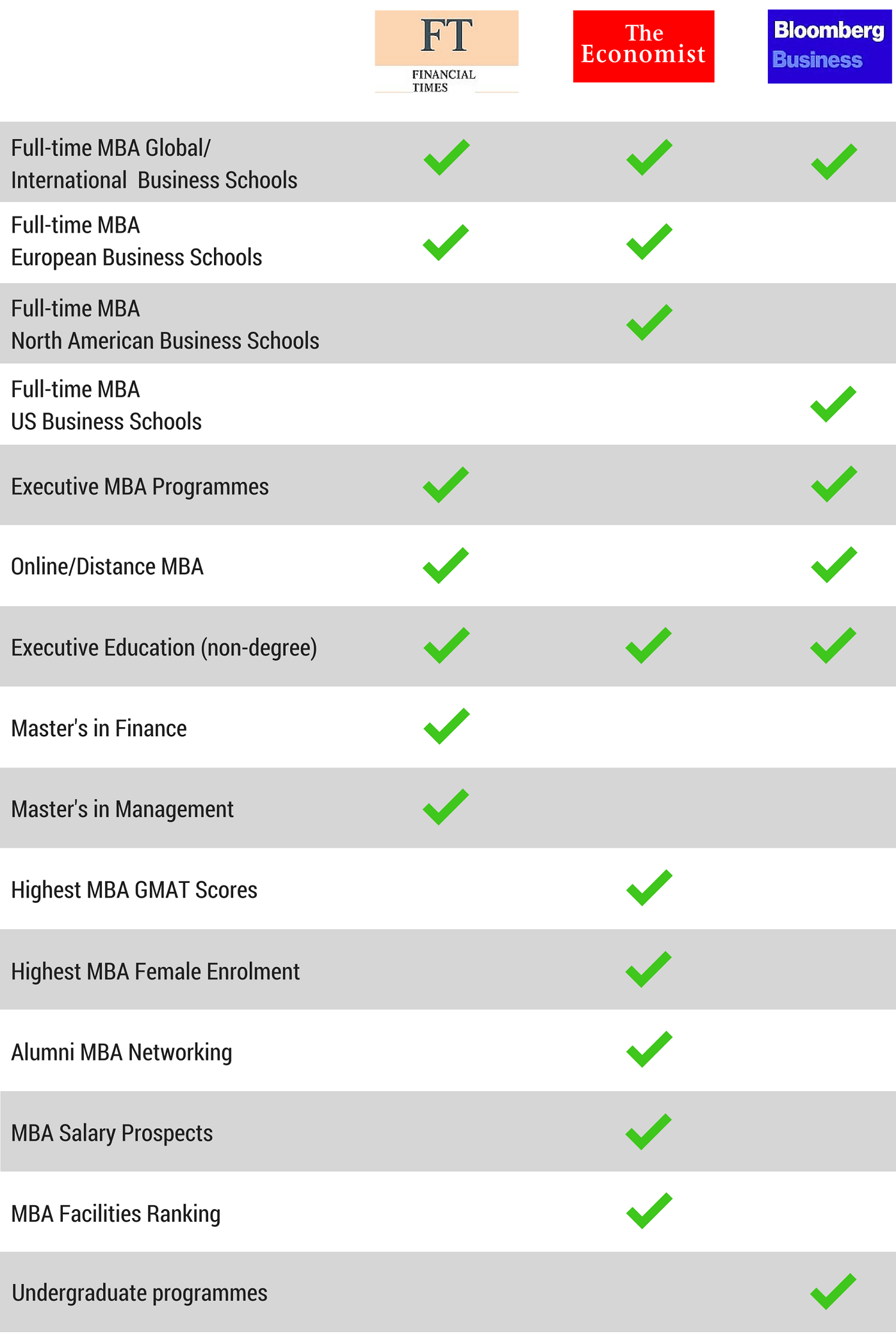
Some of the most internationally respected and popular business school rankings are the ones published by the Financial Times, The Economist, and Bloomberg BusinessWeek. There are, of course, a number of other rankings that various independent organisations publish annually, but the aforementioned ones have gained international respect and recognition.
The Financial Times Business School Rankings
The Financial Times (FT) provides some of the most popular and widely used rankings by today’s prospective applicants. The FT aims to rank the best management programmes available today.
In order to participate in some of the FT rankings, a school needs to be accredited by AACSB or EQUIS, international accreditation bodies. Additionally, the school in question must have a programme that has existed for at least four years and a class of graduates that finished their programme at least three years before the publication date of the FT rankings.
The various FT ranking tables form an interactive user-friendly tool, which allows candidates to search for the school of their interest and see it in the context of other business schools. The tables evaluate each school against a wide range of criteria including average salary after graduation, average salary increase and value for money, and additionally indicate how the particular school ranked during the previous years.
The FT releases seven different rankings annually dedicated to full-time, executive and online MBA programmes, Master’s degree programmes in Management and Finance, and executive non-degree education.
The Global MBA Ranking evaluates the world’s best full-time MBA programmes. It is arguably the most exhaustive, detailed and informative of all Financial Times’ rankings. The ranking is published in January and lists 100 business schools.
The Executive MBA Ranking lists the world’s top 100 programmes for senior working managers. Do not get confused with the ranking on executive education, as this refers to non-degree courses and tailored training. The EMBA ranking is published in October.
The Online MBA Ranking evaluates programmes that deliver online at least 70 per cent of the programme content. There are 15 business schools in the 2015 ranking, but the number is expected to grow in the coming years. The list is published in March.
The Master’s in Management Ranking assesses the world’s top pre-experience degrees in general management. Courses are one or two years in length and designed for graduates with little or no work experience. Specialised programmes are not included. The ranking lists 70 business schools and is published in September.
The Master’s in Finance Ranking evaluates two types of programmes – those that require prior work experience for admission (post-experience) and those that are open to applicants with little or no professional experience (pre-experience). The 2015 Master's in Finance Post-experience lists 5 top business schools, while the Pre-experience lists 49 top business schools. The lists are published in June.
The Executive Education Ranking evaluates non-degree courses for companies and working managers. There are actually two lists in this ranking. The ranking of executive education customised for companies lists 80 business schools. The ranking of executive education with open enrolment lists 70 business schools. The lists are published in May.
The European Business Schools Ranking is compiled based on the combined performance of European schools in the MBA, Executive MBA, Master’s in Management and non-degree executive education programmes. The online MBA and Master's in Finance rankings are not included. A European rank is produced for each type of programme. The 2014 ranking lists 80 business schools and it is published in November/December.
You can check out the latest Financial Times rankings here.
Financial Times rankings timelines and release dates:

The Economist Business School Rankings
The Economist evaluates top full-time MBA and executive MBA programmes. Based on these surveys they publish nine global and regional rankings, as well as a selection of the top schools with the highest GMAT score, female enrolment, salary prospects and alumni networking, as well as best facilities.
The Economist's business school ranking system allows users to compare schools against criteria that include overall rank, regional rank, new career opportunities, percentage in work three months after graduation, percentage who found jobs through the careers service, personal development and educational experience, faculty quality, student diversity, education experience, increase in salary, percentage increase on pre-MBA salary, post-MBA salary and others.
Various criteria are included in the calculation of The Economist final rankings and each is weighted. The main categories of criteria are new career opportunities (which accounts for 35% of the final result); personal development/education experience (35%); increase in salary (20%); and networking potential (10%). The survey asks several questions in each category and once the data has been collected, the percentages are allocated as indicated to form the final outlook of the year’s rankings.
Full-time MBA Ranking is based on an initial selection, by The Economist, of 130 leading business schools around the world. These 130 schools are invited to take part in a two-stage survey, which requires input from both schools and students/alumni. To qualify for inclusion in the ranking, schools that respond to the survey have to meet various thresholds of data provision, as well as attaining a minimum number of responses to the survey of current students and alumni who graduated within the last three years. The ranking is conducted annually and lists 100 business schools.
Executive MBA Ranking. All those schools that are included in the annual The Economist full-time ranking that have programmes delivered in a part-time format and that enrol students with significantly more work experience than those on their full-time MBAs are invited to take part in the EMBA survey. The EMBA ranking is conducted bi-annually and the 2015 ranking lists 62 business schools.
European MBA Ranking lists the top 20 business schools in Europe included in the full-time MBA ranking.
North American MBA Ranking lists 20 business schools.
Highest GMAT Scores Ranking lists the 10 business schools with the highest average GMAT scores.
Highest Female Enrolment Ranking lists the 10 business schools included in the full-time MBA ranking which enrolled the largest percentage of female students.
Alumni Networking Ranking lists the 10 business schools that are evaluated by their students as having the most useful alumni network.
Salary Prospects Ranking lists the 10 business schools which performed best when combining the post-MBA salary in USD (75% weighting) and the percentage difference between pre- and post-MBA salary (25% weighting).
Facilities Ranking ranks selected schools according to students’ assessment of the facilities and services on offer and lists 10 business schools.
Bloomberg Businessweek Business School Rankings
Another prominent ranking source is the Bloomberg Businessweek. The publishers aim to determine which business schools offer the strongest education and best prepare MBA graduates for their careers. You can find the detailed description of the methodology here.
Full-time MBA ranking lists 209 international business school profiles, of which 85 are ranked.
The full-time MBA ranking is based on three measures: a survey of student satisfaction (45% of the ranking); a survey of employers who hire those graduates (45%); and the expertise of each school’s faculty, measured by faculty research in esteemed journals (10%). Some changes have been introduced in the latest ranking methodology to improve the accuracy.
Executive MBA ranking lists 143 international business school profiles, of which 42 are ranked. The ranking is based on an online survey with EMBA graduates and directors. The survey includes questions about teaching quality, career services, curriculum, and other aspects of their experience.
Part-time MBA ranking lists 178 business school profiles, of which 78 are ranked. As announced on their website, Businessweek bases their part-time rankings on various measures of student satisfaction, post-graduation outcomes and academic quality.
Executive Education (non-degree) ranking lists 80 international business school profiles, of which 20 are ranked.
Bloomberg Businessweek also ranks Distance Learning Programmes and Undergraduate Programmes with 187 school profiles of which 10 are ranked.
Business School Rankings by Type of Programme, Region, Focus
Now that we have presented the major business school rankings, here is a summary of their listings by type of programme, region and other ranking focus which will help you check out just the right rankings for you:

Finally, a piece of advice for prospective students from Bloomberg Businessweek:
Don’t let rankings alone make your school decision for you. Our rankings and school profiles offer a thorough picture of the current landscape of full-time MBA programmes, but deciding where to go to school is a personal decision. A school that is right for one student may be wrong for another.
Find out Which Are the Best MBA Rankings?


Comments